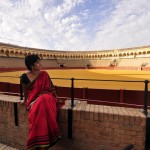Check Mate
There are few designs that never go out of style and checks are one of them. Madras has a special connection with plaid for it is this city that made the design popular. The ‘Madras’ fabric found perfect agency with the British who had acquired a strip of land called Madarasapattinam in 1639. To ensure that they had a steady supply of cloth to trade in, they brought in weavers and merchants from various parts of the country by promising them tax exemptions. Almost 400 weaver families came to settle in the new city to make Madras. The original Madras fabric was plain hand-woven cotton overprinted or embroidered in elaborate patterns using natural (vegetable) dyes. The predominant colors were shades of blue, black and red checks; it was perfect for Madras’s humid weather. And what’s more, the pattern was the same on both sides of the cloth. They loved it so much that they began to export it to their home country and its use began to spread to different parts of the Empire. Legend has it that the later checks in the 1800s, were inspired by the tartan that the British brought back with them to be incorporated into the Madras.
In the 1960s, Bleeding Madras became the rage after a lawsuit filed against Capt. C.P.Krishnan Nair, a textile exporter, morphed into a genius PR campaign by him. Customers of Brooks Brothers, New York, to whom the fabric was sold to by an American dealer, were unhappy because the Madras trousers and jackets they bought, ran colour badly. In an interview to Seventeen magazine, Nair created a story that the miracle fabric was “guaranteed to bleed” and that the washing instructions were not passed on to Brooks Brothers entirely. When the magazine came out, complete with a 7-page story of the history and manufacturing process along with glossy pictures of men in Madras, Brooks Brothers were flooded with requests from customers for more Madras items! Later, David Ogilvy also masterminded a campaign for Hathaway Madras Shirts following which, wearers couldn’t wait to have their outfits faded. It then became a ritual to wait for a new fade with every wash!
Tamil cinema wasn’t far behind. In 1961, the Saroja Devi and Sivaji Ganesan starrer Paalum Pazhamum inspired a line of checked sarees. Die-hard Saroja Devi fans will certainly have a Paalum Pazhamum in their wardrobe! My family is no different. I’ve heard several stories about Paalum Pazhamum blouses, half-sarees and sarees the women of that era wore. Made popular by Nalli, these checks have never gone out of style. They have come back time and again in various styles: checked borders, patli pallus, etc.
My first Paalum Pazhamum came as a house-warming gift from Mom last year. An Uppada in bright pink and yellow patli pallu that I wore for #sareedate Chennai earlier this month.
There’s no check-mating this design, for sure.


